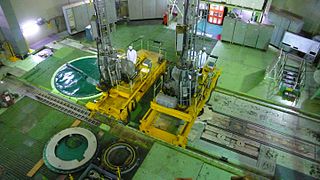
Kaiga Generating Station is a nuclear power generating station situated at Kaiga, near the river Kali, in Uttara Kannada district of Karnataka, India. The plant has been in operation since March 2000 and is operated by the Nuclear Power Corporation of India.

Madras Atomic Power Station (MAPS) located at Kalpakkam about 80 kilometres (50 mi) south of Chennai, India, is a comprehensive nuclear power production, fuel reprocessing, and waste treatment facility that includes plutonium fuel fabrication for fast breeder reactors (FBRs). It is also India's first fully indigenously constructed nuclear power station, with two units each generating 220 MW of electricity. The first and second units of the station went critical in 1983 and 1985, respectively. The station has reactors housed in a reactor building with double shell containment improving protection also in the case of a loss-of-coolant accident. An Interim Storage Facility (ISF) is also located in Kalpakkam.

The Department of Atomic Energy (DAE) is an Indian government department with headquarters in Mumbai, Maharashtra, India. DAE was established in 1954 with Jawaharlal Nehru as its first minister and Homi Bhabha as its secretary.
The Chashma Nuclear Power Plant is a large commercial nuclear power plant located at Chashma in Mianwali, Punjab, Pakistan.
In Pakistan, nuclear power is provided by six commercial nuclear power plants with a net capacity of 3,262 megawatts (3.262 GW) from pressurized water reactors. In 2020, Pakistan's nuclear power plants produced a total of 133 terawatt-hours of electricity, which accounted for roughly 10% of the nation's total electric energy generation.

Tarapur Atomic Power Station (T.A.P.S.) is located in Tarapur, Palghar, India. It was the first commercial nuclear power station built in India.

Kudankulam Nuclear Power Plant is the largest nuclear power station in India, situated in Kudankulam in the Tirunelveli district of the southern Indian state of Tamil Nadu. Construction on the plant began on 31 March 2002, but faced several delays due to opposition from local fishermen. KKNPP is scheduled to have six VVER-1000 reactors built in collaboration with Atomstroyexport, the Russian state company and Nuclear Power Corporation of India Limited (NPCIL), with an installed capacity of 6,000 MW of electricity.

Kakrapar Atomic Power Station is a nuclear power station in India, which lies in the proximity of Mandvi, Surat and Tapi river in the state of Gujarat.
The Rajasthan Atomic Power Station is a nuclear power plant located at Rawatbhata in the state of Rajasthan, India.
Nuclear power is the fifth-largest source of electricity in India after coal, gas, hydroelectricity and wind power. As of November 2020, India has 23 nuclear reactors in operation in 8 nuclear power plants, with a total installed capacity of 7,380 MW. Nuclear power produced a total of 43 TWh in 2020–21, contributing 3.11% of total power generation in India. 10 more reactors are under construction with a combined generation capacity of 8,000 MW.
Nuclear power in Romania provides around 20% of its electricity, with two nuclear reactors commencing operations in 1996 and 2007. In 2020, Romania generated a total of 56.1 TWh of electricity. The generation mix was composed of hydro (28%), nuclear (20%), natural gas (15%), coal (17%), wind (12%), solar (3%), and biofuels & waste. The Romanian government strongly supports nuclear energy.
Jaitapur Nuclear Power Project is a proposed nuclear power plant in India. If built, it would be the largest nuclear power generating station in the world by net generation capacity, at 9,900 MW. The power project is proposed by Nuclear Power Corporation of India (NPCIL) and would be built at Madban village of Ratnagiri district in Maharashtra.

The Civil Liability for Nuclear Damage Act, 2010 or Nuclear Liability Act is a highly debated and controversial Act which was passed by both houses of Indian parliament. The Act aims to provide a civil liability for nuclear damage and prompt compensation to the victims of a nuclear incident through a no-fault liability to the operator, appointment of Claims Commissioner, establishment of Nuclear Damage Claims Commission and for matters connected therewith or incidental thereto.

The Gorakhpur Nuclear Power Plant or the Gorakhpur Haryana Anu Vidyut Pariyojana (GHAVP) is a proposed nuclear power plant to be built on a 560 hectares area west of Gorakhpur village of Fatehabad district of Haryana.

Sekhar Basu was an Indian nuclear scientist who served as the chairman of the Atomic Energy Commission and Secretary to the Government of India, Department of Atomic Energy (DAE). He also served as the Director of Bhabha Atomic Research Centre (BARC), the Project Director of Nuclear Submarine Program, and later as the Chief Executive of the Nuclear Recycle Board at Bhabha Atomic Research Center. He was a recipient of India's fourth highest civilian honor Padma Shri in 2014.
The Chutka Nuclear Power Plant is a proposed nuclear power plant to be built on a 1,200 acres (490 ha) area, near Chutka Village of Mandla district of Madhya Pradesh. The site is near Kanha National Park, one of the tiger reserves of India and the largest national park of Madhya Pradesh state in India.

The IPHWR-700 is an Indian pressurized heavy-water reactor designed by the NPCIL. It is a Generation III reactor developed from earlier CANDU based 220 MW and 540 MW designs. It can generate 700 MW of electricity. Currently there is two unit operational, 6 units under construction and 8 more units planned, at a cost of ₹1.05 lakh crore (US$13 billion).
Haripur Nuclear Power Plant is a proposed nuclear power station by Nuclear Power Corporation of India (NPCIL), that is intended to be constructed at Haripur village in Purba Midnapore district, West Bengal.
The Mahi Banswara Rajasthan Atomic Power Plant (MBRAPP) is a proposed nuclear power plant to be built on a 1,366.49 acres (553.00 ha) area, near Banswara district of Rajasthan.










